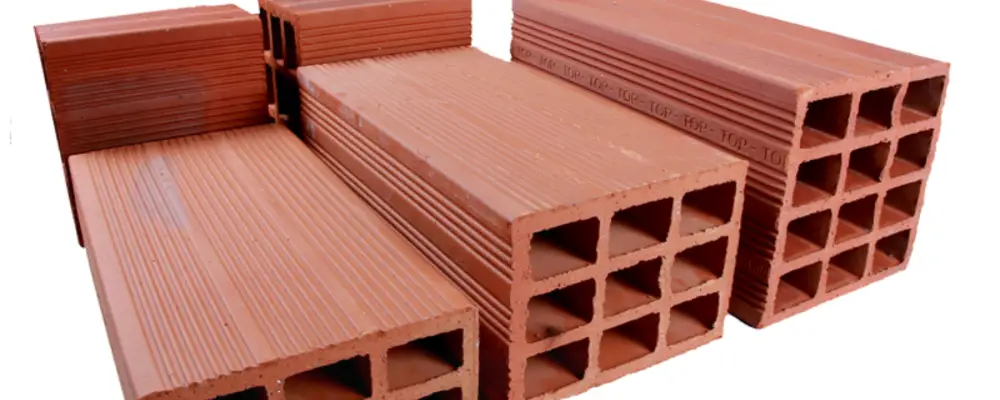In the ever-growing construction industry, there are several types of bricks available. Porotherm bricks have a unique identity, distinguishing them from other brick types. Do you need clarification about using Porotherm bricks for your dream project? We’ve got you covered. This blog explains the pros, cons, applications and suitability of Porotherm bricks in construction.
Overview of Porotherm Bricks
Porotherm bricks are perforated bricks made using clay, rice husk, fly ash and slurry from granite. These bricks are available in horizontal and vertical forms, offering good thermal insulation properties and protecting the structure from extreme external temperatures. These bricks are eco-friendly and have a wide range of advantages. Due to numerous benefits and vast applications, these are widely preferred among builders.
Advantages & Disadvantages of Porotherm Bricks

Advantages
- These bricks are strong and durable and can be used as both load-bearing and non-lead-bearing walls of the structure.
- They are lightweight and easy to handle. This reduces the chances of breaking bricks while carrying them to the upper floors.
- The lightweight nature of the bricks reduces the overall dead load and cost of the structure.
- These bricks are highly durable and can withstand for a longer period of time, up to 150 years.
- These bricks have excellent thermal and acoustic insulation that helps build more secure rooms and structures without being affected by external noises and temperatures.
- These bricks are highly resistant to fire and water, so they can be used in extreme weather conditions and be applied in all types of construction.
- These bricks are made completely using natural resources and waste (i.e., slurry & fly ash), making them eco-friendly and suitable for constructing green buildings.
- These bricks can help the building maintain the room temperature throughout the year. They keep the structure cool during summer and warm during winter.
- The lightweight nature and easy handling make it easy to install, maintain, and repair.
- Using Porotherm bricks instead of traditional bricks reduces the construction time.
Disadvantages
- Due to low density and high water pressure, these bricks cannot be used for large, high-rise structures, especially in the foundation and base slab.
- These bricks have high efflorescence when exposed to water. They form a white powdery layer on the bricks, affecting the structure’s unplastered aesthetic.
- The manufacturing process and construction using these bricks require skilled labour.
- The availability of these bricks is limited and high demand raises the price.
Are Porotherm Bricks Suitable for your Project?

Porotherm bricks are applicable in almost all types of construction and are one of the most preferred brick types in modern construction fields. Here, we look at some factors that will help you understand why Porotherm bricks could suit your dream construction project.
- These bricks are 60% lightweight compared to conventional building materials, which reduces the dead load and the overall structural cost.
- The lightweight nature of the brick makes it easy to handle, boosting the construction speed.
- They are good thermal insulators and are 45% more efficient in resisting heat than traditional construction materials.
- The brick’s thermal properties save energy on heat reduction and air consumption.
- The raw materials used in producing porotherm bricks use clay from de-silted dead water tanks and natural additives such as coal ash, sawdust, and rice husk. Using waste materials makes it an eco-friendly brick option, credited by the Indian Green Building Council for ratings.
- Porotherm bricks consume less water for the manufacturing and construction process when compared to other building materials.
- They have a high compressive strength of 10 N/mm², which is comparatively greater than concrete bricks. This high compressive strength makes it applicable for load-bearing structures.
- These bricks are highly durable, can last for more than 150 years, and are an ideal material for permanent structures.
- These bricks can be recycled and reused and are ideal for Green Buildings.
Recommendations of Porotherm Bricks for Specific Projects
Although Porotherm bricks are used for various construction projects, they cannot be employed in certain structures. Here are some factors that affect the usability of Porotherm bricks in specific projects.
- Porotherm bricks have a density of 694 to 783 kg/m³, which is comparatively lower than conventional bricks. This makes them unsuitable for large structures.
- The Porotherm bricks have a water absorption ratio of 15%, which is higher than clay bricks. This makes them unsuitable for structures prone to water damage and located near the water table.
- These bricks have a high efflorescence rate and could fall victim to salt attacks when exposed to water and excess moisture.
- These bricks cannot be used to construct foundations and base slabs, where the negative pressure of water and capillary action could reduce the stability of the structure.
- These bricks have a high demand in areas with limited availability, which naturally increases the cost of the bricks.
Conclusion
Porotherm bricks have been a game changer in the construction field. These bricks save a lot of time and money in the production and construction. These bricks reduce the use of traditional bricks, steel, and other building materials. The lightweight nature, high resistance against heat and sound and durability boost the structure’s lifespan. These bricks can also be combined with interior decorations, glass and paint to give an aesthetically pleasing look. On the other hand, these bricks require skilled construction labour, and their limited availability increases their price.

